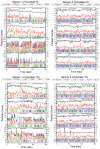COVID-19 in the Clinic: Human Testing of an Aerosol Containment Mask for Endoscopic Clinic Procedures
- PMID: 34311614
- PMCID: PMC8978456
- DOI: 10.1177/01945998211029184
COVID-19 in the Clinic: Human Testing of an Aerosol Containment Mask for Endoscopic Clinic Procedures
Abstract
Objective: To create an aerosol containment mask (ACM) for common otolaryngologic endoscopic procedures that also provides nanoparticle-level protection to patients.
Study design: Prospective feasibility study .
Setting: In-person testing with a novel ACM.
Methods: The mask was designed in Solidworks and 3D printed. Measurements were made on 10 healthy volunteers who wore the ACM while reading the Rainbow Passage repeatedly and performing a forced cough or sneeze at 5-second intervals over 1 minute with an endoscope in place.
Results: There was a large variation in the number of aerosol particles generated among the volunteers. Only the sneeze task showed a significant increase compared with normal breathing in the 0.3-µm particle size when compared with a 1-tailed t test (P = .013). Both the 0.5-µm and 2.5-µm particle sizes showed significant increases for all tasks, while the 2 largest particle sizes, 5 and 10 µm, showed no significant increase (both P < .01). With the suction off, 3 of 30 events (2 sneeze events and 1 cough event) had increases in particle counts, both inside and outside the mask. With the suction on, 2 of 30 events had an increase in particle counts outside the mask without a corresponding increase in particle counts inside the mask. Therefore, these fluctuations in particle counts were determined to be due to random fluctuation in room particle levels.
Conclusion: ACM will accommodate rigid and flexible endoscopes plus instruments and may prevent the leakage of patient-generated aerosols, thus avoiding contamination of the room and protecting health care workers from airborne contagions.
Level of evidence: 2.
Keywords: COVID-19; Rainbow Passage; aerosol production; cough; endoscopy; laryngoscopy; nasal endoscopy; negative-pressure mask; sneeze; virus.
Conflict of interest statement
Figures




References
Publication types
MeSH terms
Substances
LinkOut - more resources
Full Text Sources
Medical
Research Materials

